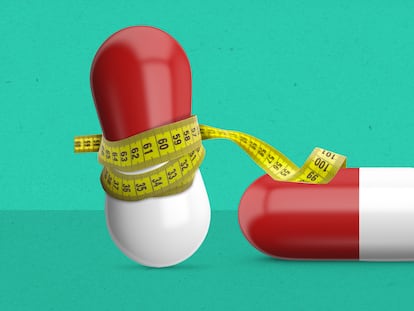Ozempic, the injections that treat type 2 diabetes and promise to end obesity are flooding the black market
Known as the “Hollywood drug,” it has become wildly popular after several actresses and influencers used it to lose weight quickly
It’s easy to get his contact information on a website for buying and selling second-hand items. He says his name is Wilson; he doesn’t have a profile picture and his status is a generic “hi, I’m using WhatsApp.” But he replies to the message right away, “Thank you for contacting us regarding our medicine. One box costs €160 ($173.54).” The box to which he refers contains a single dose of Ozempic, the type 2 diabetes drug that has been shown to dramatically aid weight loss. In Spain, it can be purchased with a prescription at the pharmacy; for diabetics, it is financed by the state and costs €4.24 ($4.60) for four doses. But obese patients and those with related health problems pay €130 ($141) out of pocket for the same drug.
Wilson charges far more than the drug’s market price, but he offers other advantages, as he explains at a frenetic pace: “No, you don’t need a prescription; customer safety and satisfaction is our priority.” “We deliver it right to your door.” “We accept payment through Bizum [a payment app].” “After this first transaction, you will be happy to do business with us again. That’s a promise.” A Google search of his phone number brings up quirky results; it’s scattered in various ads on secondhand websites. He offers rohypnol, trankimazin, elvanse... He has everything for everyone, but in the last few months, he has been pushing Ozempic the most.
They call Ozempic the “Hollywood drug,” and it is the best known of its class of medication, GLP-1 receptor agonists, which could end obesity worldwide. Ozempic is a weekly injectable drug and in clinical trials it has been shown to promote a weight loss of about 15%. Although it has been approved and prescribed in Spain since 2017, its fame seems to have exploded in recent months, leading to shortages and people’s obsession with getting their hands on the precious injections.
The drug went from doctors’ offices to social media after Kim Kardashian was rumored to have used it to fit into Marilyn Monroe’s dress for the 2022 MET Gala, setting off a frenzy. The same magazines that criticized celebrities’ bodies began to speculate about who had lost weight suspiciously fast and how. Social media has spread the obsession with the drug. On TikTok, the hashtag Ozempic brings up videos that have been viewed 674 million times. “It’s true that they talk about it in the gym,” confirms Teresa (not her real name), a personal trainer at an exclusive sports center in Madrid, Spain. “There’s a client who uses it and I know of a trainer at the [fitness] center who supplements his workouts with injections,” she says. She points out that the craze has been imported from the United States; it is not discussed openly. But not since Botox and Viagra has a drug garnered so much interest.
The drug is intended to treat diabetes, which is an epidemic. According to data from the International Diabetes Federation, it affects one in seven adults in Spain. The concomitant health expenditure exceeds €13.43 billion ($14.57 billion). Obesity affects millions of people and is linked to over 200 diseases and cardiovascular problems. According to the OECD, the complications of being overweight account for 9.7% of total healthcare spending in Spain. The use of GLP-1 receptor agonists could represent a turning point in the battle of the bulge, which we have been fighting (and losing) for decades. But the promise of effortless weight loss with one shot per week doesn’t just interest people with health problems.
Maria (not her real name) is overweight but not to the point that she needs to be prescribed Ozempic. She obtained the drug by other means; she prefers not to elaborate. “The first day was horrible, I injected myself with too much and I got sick, [I felt] nauseous and awful,” she explains in an exchange of audio messages. But then things got better. She had been on diets before and lost weight through sheer willpower, salads, sweat and tears. But this time was different: “I lost the desire to eat, especially to eat junk food,” she explains. “I order food on Glovo [a food delivery service]; normally, if I’m on a diet, I poke around on the app and think: ‘Should I order or not, maybe I shouldn’t...’ But I end up doing it. When I was taking my shots, I didn’t even look at Glovo; thinking about a hamburger made me sick.” Maria did not change her habits when she was taking the injections. Her body was asking for “less and healthier food,” but she did not diet or exercise. Even so, she lost five kilos (about 11 pounds). After two months, she stopped taking the injections and regained the weight.
“If we use these drugs without changing our lifestyle, we accomplish absolutely nothing,” Juan Jose Gorgojo, the director of nutrition services at the Fundación Alcorcón University Hospital, explains by telephone. Gorgojo is extremely critical of people who use these drugs for aesthetic purposes. “The cult of the body makes people lose perspective. I think it is an abomination to use these life-saving drugs so frivolously,” he says.
Maria’s case contrasts with that of 45-year-old Javier Diaz. When he started taking Ozempic, he weighed 112 kilos (about 247 pounds), had high transaminase levels and was in the early stages of type 2 diabetes. Along with the injections, he changed his diet and established an exercise routine. “What has happened to me is wonderful, plain and simple,” he says over the phone. “Before, I could barely walk down the stairs in my house, and just this morning I did 100 squats.”

Diaz has been dieting since he was 16 years old. Nothing worked for him, at least not permanently. Last May, he went to see an endocrinologist, and things have been going well since. But Ozempic is expensive. Diaz is aware that not everyone can afford his treatment. In the year he has been using the drug, he has lost 26 kilos (about 57 pounds) and spent over €1,500 ($1,627.14). Many endocrinologists are fighting for the State to pay for cases like Diaz’s.
One such physician is Dr. Gorgojo. “It seems like we reward the patient for becoming diabetic and we [only] finance the drug then,” he laments. “If [a patient] has problems with obesity, we don’t finance it. But if the patient develops, say, cardiovascular problems over the years because of that obesity, we are going to finance a stent for their arteries, we are going to pay for heart surgery. Do we really have to let it get to that point? Wouldn’t it be better to invest earlier and prevent these complications from occurring?” the endocrinologist wonders. Gorgojo is fighting for obesity to be recognized “as a real disease.” Meanwhile, the pharmaceutical companies are engaged in another battle. They promise shots for everyone. To achieve that, they are embarking on a lucrative race, which promises to line their pockets and empty our refrigerators.
Cristóbal Morales is an endocrinologist at the Virgen de la Macarena Hospital in Seville, Spain. He has conducted over 120 clinical trials on the GLP-1 receptor, which gives him a perspective on the future of the drugs. He shares good news over the phone: “In the future we’ll have molecules that are three times more effective than the ones we have now.” Morales mentions Wegovy, a higher-dose version, which is designed specifically for people who are overweight or obese. It became tremendously popular in the United States after Elon Musk proclaimed its benefits. Denmark and the UK already market it. “We are waiting to launch it in Spain; we are the next country,” the doctor says.
There is another GLP-1 agonist drug, tirzepatide, which is already being marketed in the United States (there’s also already a shortage). And another drug, known as CagriSema, combines semaglutide with another drug and leads to more weight loss than its predecessors. Denmark’s Novo Nordisk (the owner of Wegovy and Ozempic) is leading the way and claims that this year it will double last year’s sales. Investors agree; in two years, its market capitalization has doubled to $326 billion (€300 billion), making it the world’s second-largest pharmaceutical company. The third and fourth largest, Pfizer and Eli Lilly, are also developing new drugs.
Analysts talk about an “obesity gold rush” and believe that the GLP-1 market could reach $150 billion by 2031 (a figure similar to the profits of the world’s largest oil company or of cancer drugs).
According to Morales, the next three years will be crucial for this field. Both our weight and our relationship with food could change as a result. The doctor is a member of the Spanish Obesity Society (SEEDO), so he is keenly aware of how medicine and society treat overweight people. He avers that there’s a tendency to blame the patient for a social, psychological, environmental problem... a complex problem that affects specific people but has global consequences. According to the latest World Atlas of Obesity, the annual cost of being overweight could reach four trillion dollars internationally by 2035 (2.9% of global GDP, up from 2.2% in 2019). The impact of these new drugs could be critical for avoiding those figures, as well as for improving—or even saving—the lives of millions of people.
Sign up for our weekly newsletter to get more English-language news coverage from EL PAÍS USA Edition
Tu suscripción se está usando en otro dispositivo
¿Quieres añadir otro usuario a tu suscripción?
Si continúas leyendo en este dispositivo, no se podrá leer en el otro.
FlechaTu suscripción se está usando en otro dispositivo y solo puedes acceder a EL PAÍS desde un dispositivo a la vez.
Si quieres compartir tu cuenta, cambia tu suscripción a la modalidad Premium, así podrás añadir otro usuario. Cada uno accederá con su propia cuenta de email, lo que os permitirá personalizar vuestra experiencia en EL PAÍS.
¿Tienes una suscripción de empresa? Accede aquí para contratar más cuentas.
En el caso de no saber quién está usando tu cuenta, te recomendamos cambiar tu contraseña aquí.
Si decides continuar compartiendo tu cuenta, este mensaje se mostrará en tu dispositivo y en el de la otra persona que está usando tu cuenta de forma indefinida, afectando a tu experiencia de lectura. Puedes consultar aquí los términos y condiciones de la suscripción digital.
More information
Archived In
Últimas noticias
Mexican peso defies uncertainty with forecasts of a new period of stability in 2026
Meghan Markle’s year of redemption: Numerous projects, some setbacks and a brand that is finally taking off
David King, chemist: ‘There are scientists studying how to cool the planet; nobody should stop these experiments from happening’
The end of the American dream gives way to Guatemalan opportunity
Most viewed
- Sinaloa Cartel war is taking its toll on Los Chapitos
- Oona Chaplin: ‘I told James Cameron that I was living in a treehouse and starting a permaculture project with a friend’
- Reinhard Genzel, Nobel laureate in physics: ‘One-minute videos will never give you the truth’
- Why the price of coffee has skyrocketed: from Brazilian plantations to specialty coffee houses
- Silver prices are going crazy: This is what’s fueling the rally











































